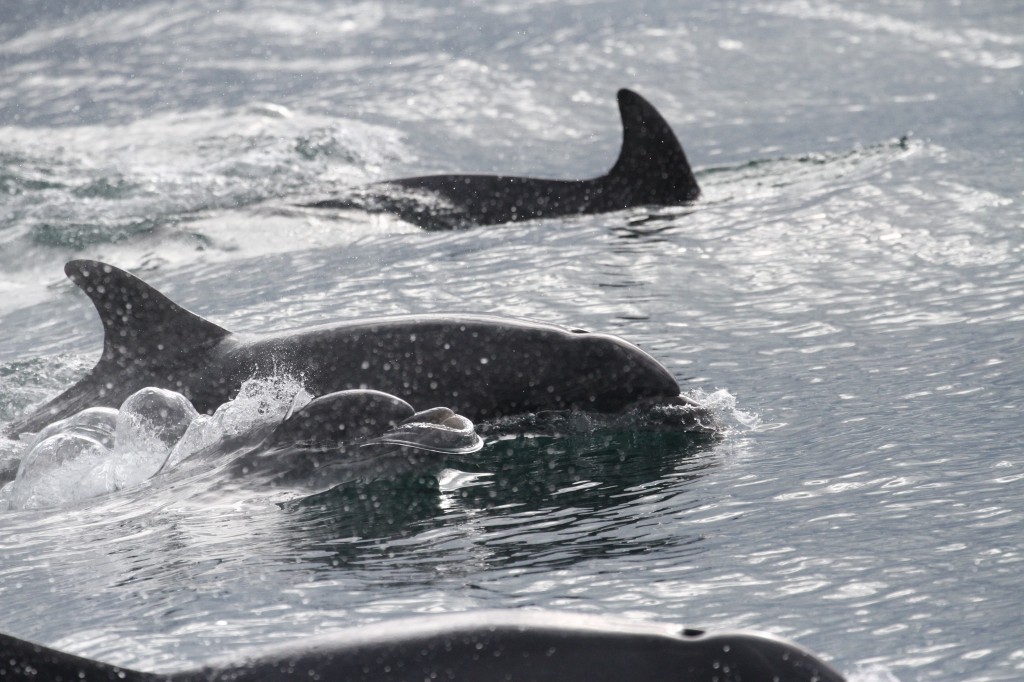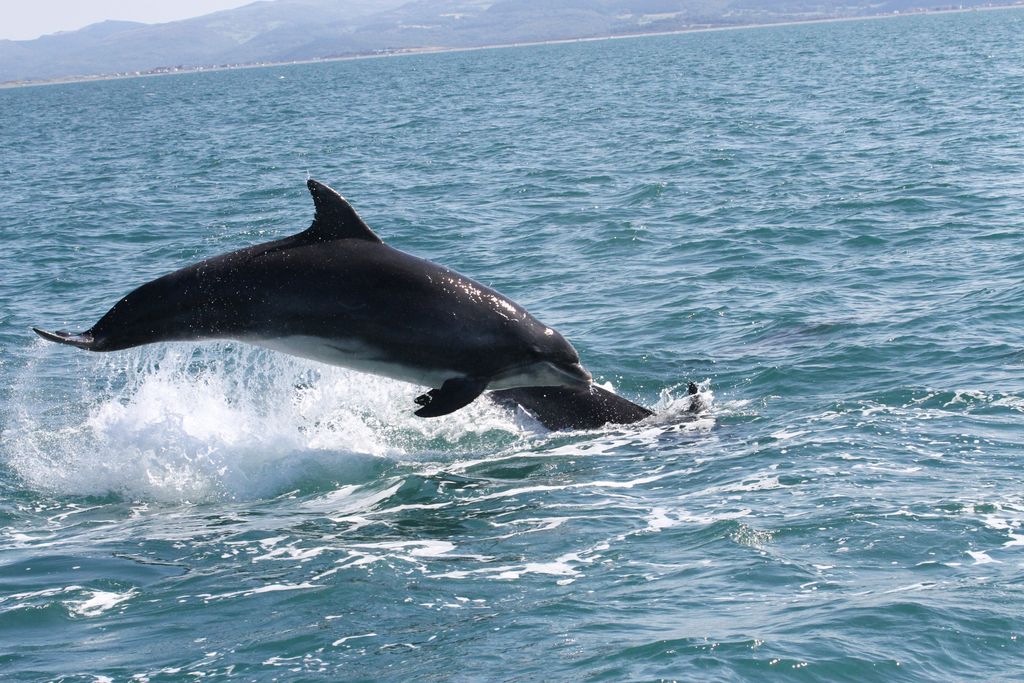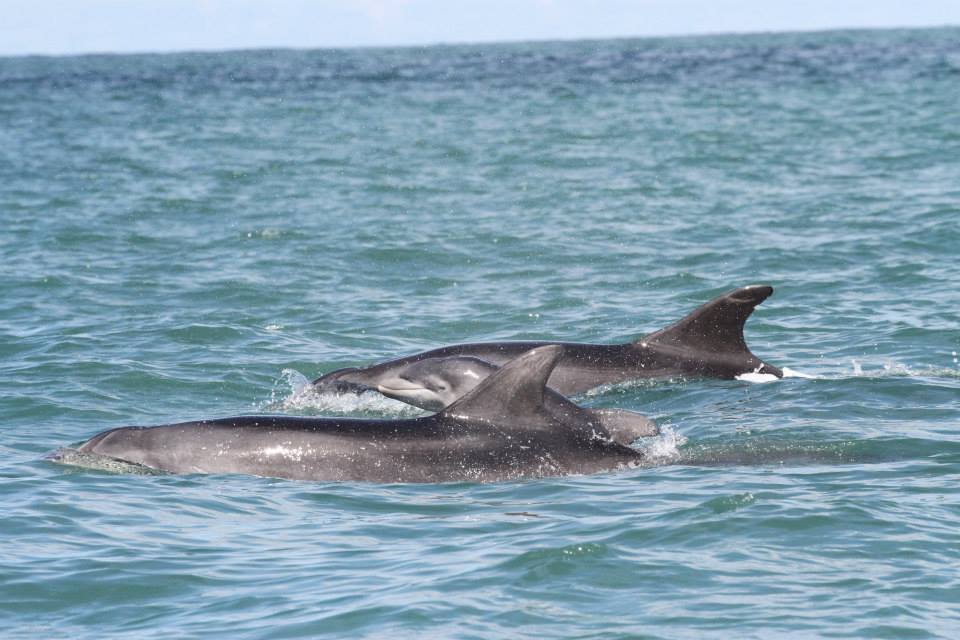Witnessing a cetacean sighting is, in the eyes of many, an unparalleled thrill. An experience guaranteed to render you speechless, or, in the case of cetacean fanatics like myself, emitting unintelligible squeals of delight. So how then amidst all this excitement does the Sea Watch team keep track of the marine mammals along the Welsh coast? The key tool is photo identification. This non-invasive technique is a valuable insight into the lives of Cardigan Bay’s dolphins.
The researchers at Sea Watch have a license to approach the bottlenose dolphins they study. Frequently, the animals approach the boat for their close-up! Photo by Katrin Lohrengel/ Sea Watch Foundation
Different species of animal have certain distinguishable features that vary from each individual. Tigers have unique facial stripes, whilst Gorillas are recognised by the shape of their noses. For bottlenose dolphins, researchers use the dorsal fin, examining the size, shape and position of any nicks and notches that can easily identify the animal. They also look for discernible scratches, scars, lesions, pigmentation, and any distinct shapes of the fin itself. Easy enough… if we were looking at a more static animal! Getting the right shot can prove difficult with one of the world’s most acrobatic creatures, but with a license to approach within 100m, this allows for a close encounter. Combine this with patience, great timing, and a high shutter speed on that top quality camera you can capture a clear shot…dolphin permission granted that is.
The acrobatic Flint, is often seen off Aberystwyth in central Cardigan Bay.
Photo by Katrin Lohrengel/ Sea Watch Foundation
Flint can be recognised by comparing the nicks and notches on his dorsal fin to the Sea Watch catalogue of dolphins using the bay. Photo by Katrin Lohrengel/ Sea Watch Foundation
Once the camera is filled with fins, the photographic information is then used in the matching process to determine the identity of the dolphins. At Sea Watch, the ID catalogue is divided into two main categories of fins: the ‘marked’ and the ‘unmarked’. ‘Marked’ is then split into ‘well’ or ‘slightly’ marked animals, both of which can be identified from either side, with the well-marked even being recognisable from poor quality photos. Those which are ‘unmarked’ are divided into ‘right’ and ‘left’, and can only be recognised from either their right or left side, with a smooth fin and no irregularities. The more a dolphin is identified using this technique the more information can be gained about the animal’s movements and habitat preference. Photo ID also gives the team a good idea of population, social structure, habitat use, individual growth and reproductive rates, along with mortality rates. Evidence so far suggests that 53 – 63% of Cardigan Bay’s dolphin population are residents, with 20-29% occasional visitors and 17-19% transients. So far there is a minimum total of 382 dolphins catalogued! It has been quite apparent in previous years that bottlenose dolphins favour the shallow, sheltered waters of the bay. However, over the last seven years the population of the Bay’s dolphins has declined, with some of Cardigan’s recognisable dolphins disappearing from the Bay – but popping up in North Wales, suggesting they have left the bay and made a move northward. The ongoing work of the SeaWatch team allows us to continually build an understanding of the complex nature of our dolphin population.
Nic Nic (pictured behind) is another of the dolphins frequently seen in Cardigan Bay. Here she is seen with another female and her new calf. Photo by Katrin Lohrengel/ Sea Watch Foundation
Photo identification is instrumental within the Adopt a Dolphin program, monitoring each individual animal in the scheme to keep adoptees updated with the progress of their favourite dolphins. This project is vital in funding the continual research that Sea Watch does but most importantly it’s a fantastic opportunity for people to get personally involved and establish a connection to the marine environment around them. Whether you chose the acrobatic Flint, playful Smoothy or the reliable Nic Nic, as an adoptee you can track where your particular dolphin was last spotted using a special log in. This sense of guardianship develops a strong need to protect and a greater awareness of the threats which these dolphins regularly face, such as marine litter, noise pollution, fishing nets and boat strikes. You’re not just adopting a dolphin, you’re actively becoming a conservation warrior! Without Photo ID, it would prove difficult to recognise Smoothy and her distinct four nicks and Bond’s tall, pointed dorsal fin.
So, take your first step to becoming a conservation warrior and adopt a dolphin! Make the most of photo ID, a fundamental research tool, by checking out Smoothy, Chris or Flint and see what they’re up to. Take a peek into the wonderful life of the bottlenose dolphin.
By Leanne Dixon
Leanne is a Sea Watch volunteer. If you’d like to volunteer your skills please contact kathy.james@seawatchfoundation.org.uk, or mathew.clough@seawatchfoundation.org.uk if you live in Wales.
If you would like to adopt a dolphin for yourself or as a present, please visit: www.adoptadolphin.org.uk (order before December 22nd if you intend it as a Christmas present in 2015!)
If you would like to apply to help with our research in Cardigan Bay, please read more here: www.seawatchfoundation.org.uk/internships




























